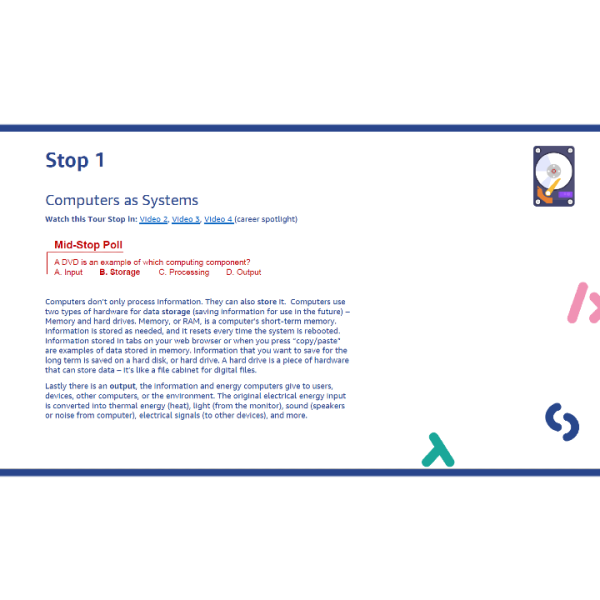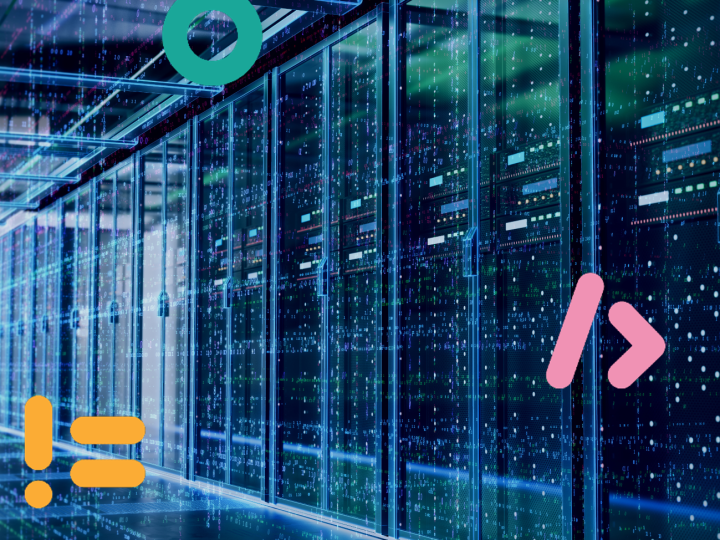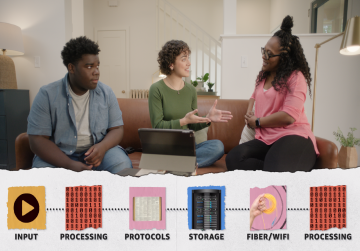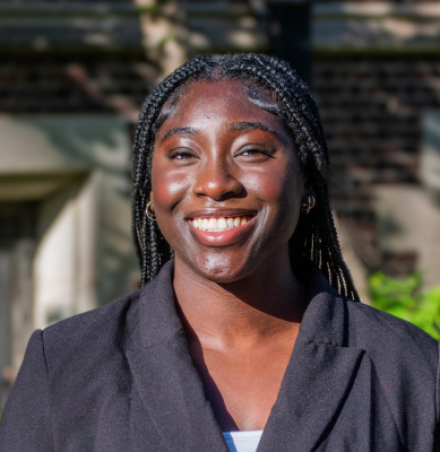AWS Data Center Tour 1:
Uncovering Cloud Computing
Discover how we went from renting movies at the store to streaming from anywhere, at any time, with this free and interactive behind-the-scenes Data Center Career Tour!
0:00 / 0:00
Video Companion

Students gain exposure to the careers of the future as they discover how careers at Amazon Web Services and Data Centers allow you to stream from anywhere at anytime, as well as store data safely and sustainably.
In this tour, students explore the following careers: Hardware Engineer, Data Center Operations Technician (DCO), Fiber Splicer, Network Engineer
In this tour, students explore the following careers: Hardware Engineer, Data Center Operations Technician (DCO), Fiber Splicer, Network Engineer

The 45 minute, interactive tour is aligned to Next Generation Science Standards (NGSS) and CSTA K-12 Computer Science Standards. The Teacher Toolkit includes a facilitation guide, worksheets, and other resources to support learning during the tour. Recommended for grades 3+.
Uncovering Cloud Computing is aligned to the following CSTA standards.
The tour is aligned to the following Next Generation Science Standards (NGSS) disciplinary core ideas, crosscutting concepts, and science and engineering practices.
Uncovering Cloud Computing is aligned to the following CSTA standards.
- 1B-IC-18 Discuss computing technologies that have changed the world, and express how those technologies influence, and are influenced by, cultural practices.
- 1B-CS-01 Describe how internal and external parts of computing devices function to form a system.
- 1B-CS-02 Model how computer hardware and software work together as a system to accomplish tasks.
- 2-CS-02 Design projects that combine hardware and software components to collect and exchange data. Collecting and exchanging data involves input, output, storage, and processing.
- 2-IC-20 Compare tradeoffs associated with computing technologies that affect people’s everyday activities and career options.
- 2-NI-04 Model the role of protocols in transmitting data across networks and the Internet.
- 3A-CS-02 Compare levels of abstraction and interactions between application software, system software, and hardware layers.
- 3A-NI-04 Evaluate the scalability and reliability of networks, by describing the relationship between routers, switches, servers, topology, and addressing.
The tour is aligned to the following Next Generation Science Standards (NGSS) disciplinary core ideas, crosscutting concepts, and science and engineering practices.
- Crosscutting Concept: Cause and Effect Events have causes, sometimes simple, sometimes multifaceted.
- Crosscutting Concept: Systems and System Models A system is an organized group of related objects or components; models can be used for understanding and predicting the behavior of systems.
- Crosscutting Concept: Scale, Proportion, and Quantity In considering phenomena, it is critical to recognize what is relevant at different size, time, and energy scales, and to recognize proportional relationships between different quantities as scales change.
- Crosscutting Concept: Energy and Matter Tracking energy and matter flows, into, out of, and within systems helps one understand their system’s behavior.
- 4-PS3-2 Energy Make observations to provide evidence that energy can be transferred from place to place by sound, light, heat, and electric currents.
- 4-PS4-3 Waves and Their Applications in Technologies for Information Transfer Generate and compare multiple solutions that use patterns to transfer information.
- MS-PS4-2 Waves and their Applications in Technologies for Information Transfer, develop, and use a model to describe that waves are reflected, absorbed, or transmitted through various materials.
- MS-PS4-3 Waves and their Applications in Technologies for Information Transfer Integrate qualitative scientific and technical information to support the claim that digitized signals are a more reliable way to encode and transmit information than analog signals.
- HS-PS3-3 Energy Design, build, and refine a device that works within given constraints to convert one form of energy into another form of energy.
- HS-PS4-2 Waves and their Applications in Technologies for Information Transfer Evaluate questions about the advantages of using digital transmission and storage of information.
- HS-PS4-5 Waves and their Applications in Technologies for Information Transfer Communicate technical information about how some technological devices use the principles of wave behavior and wave interactions with matter to transmit and capture information and energy.
- HS-ETS1-3 Engineering Design Evaluate a solution to a complex real-world problem based on prioritized criteria and trade-offs that account for a range of constraints, including cost, safety, reliability, and aesthetics as well as possible social, cultural, and environmental impacts.

Kahoot!: The fun, game-like tour is available for FREE on Kahoot! to all interested classrooms and families. Students can play each other while learning about cloud computing. No account required.
Discovery Education: Grounded in Discovery Education’s expertise in teaching and learning, Ready-to-Use Activities save educators time with engaging content and instructional strategies to bring STEM careers to life for students.
In this tour, “the cloud” is brought down to earth as your students learn about the hardware, infrastructure, and talented professionals that, together, allow us to stream movies and music, and carry the world in our pockets. Students complete activities to stay engaged throughout the entire experience.
Discovery Education: Grounded in Discovery Education’s expertise in teaching and learning, Ready-to-Use Activities save educators time with engaging content and instructional strategies to bring STEM careers to life for students.
In this tour, “the cloud” is brought down to earth as your students learn about the hardware, infrastructure, and talented professionals that, together, allow us to stream movies and music, and carry the world in our pockets. Students complete activities to stay engaged throughout the entire experience.
Teacher Toolkit
Our Teacher Toolkit provides educators with guides, worksheets, and other documents aligned to CSTA K-12 Computer Science Standards and Next Generation Science Standards (NGSS). Use these materials to discover all the possibilities with computer science learning and careers of the future, and to set students up for success before, during, and after the tour.
-
 Student WorksheetDistribute graphic organizers for students to capture their biggest learnings and wonderings on the Uncovering Cloud Computing tour.
Student WorksheetDistribute graphic organizers for students to capture their biggest learnings and wonderings on the Uncovering Cloud Computing tour. Distribute graphic organizers for students to capture their biggest learnings and wonderings on the Uncovering Cloud Computing tour.Distribute graphic organizers for students to capture their biggest learnings and wonderings on the Uncovering Cloud Computing tour.
Distribute graphic organizers for students to capture their biggest learnings and wonderings on the Uncovering Cloud Computing tour.Distribute graphic organizers for students to capture their biggest learnings and wonderings on the Uncovering Cloud Computing tour. -
 Facilitation GuideRead instructions for setting up the Kahoot! tour with classes. Slide by slide script for delivering the Uncovering Cloud Computing tour to students.
Facilitation GuideRead instructions for setting up the Kahoot! tour with classes. Slide by slide script for delivering the Uncovering Cloud Computing tour to students. Read instructions for setting up the Kahoot! tour with classes. Slide by slide script for delivering the Uncovering Cloud Computing tour to students.Read instructions for setting up the Kahoot! tour with classes. Slide by slide script for delivering the Uncovering Cloud Computing tour to students.
Read instructions for setting up the Kahoot! tour with classes. Slide by slide script for delivering the Uncovering Cloud Computing tour to students.Read instructions for setting up the Kahoot! tour with classes. Slide by slide script for delivering the Uncovering Cloud Computing tour to students. -
 Key Student LearningsDiscover the key vocabulary and learnings covered on the Uncovering Cloud Computing tour by tour stop.
Key Student LearningsDiscover the key vocabulary and learnings covered on the Uncovering Cloud Computing tour by tour stop. Discover the key vocabulary and learnings covered on the Uncovering Cloud Computing tour by tour stop.Discover the key vocabulary and learnings covered on the Uncovering Cloud Computing tour by tour stop.
Discover the key vocabulary and learnings covered on the Uncovering Cloud Computing tour by tour stop.Discover the key vocabulary and learnings covered on the Uncovering Cloud Computing tour by tour stop. -
 CertificatePrint and distribute student certificates to celebrate completing the tour!
CertificatePrint and distribute student certificates to celebrate completing the tour! Print and distribute student certificates to celebrate completing the tour!Print and distribute student certificates to celebrate completing the tour!
Print and distribute student certificates to celebrate completing the tour!Print and distribute student certificates to celebrate completing the tour!
To view this resource, please complete the following:
FAQs
What will my class see on the tours?
On the Uncovering Cloud Computing tour, students will discover how the cloud and data centers enable them to stream movies from anywhere at anytime. They’ll learn the components of a computer, a high-level overview of the cloud, how data moves through fiber optic cables, and protocols let data know where to go! Along the way, they’ll meet a hardware engineer, a data center operator (DCO), a fiber splicer, and a network engineer.
To learn more, check out the teacher toolkit resources.
To learn more, check out the teacher toolkit resources.
What CSTA standards is the tour aligned to?
Uncovering Cloud Computing is aligned to the following CSTA standards.
- 1B-IC-18 Discuss computing technologies that have changed the world, and express how those technologies influence, and are influenced by, cultural practices.
- 1B-CS-01 Describe how internal and external parts of computing devices function to form a system.
- 1B-CS-02 Model how computer hardware and software work together as a system to accomplish tasks.
- 2-CS-02 Design projects that combine hardware and software components to collect and exchange data. Collecting and exchanging data involves input, output, storage, and processing.
- 2-IC-20 Compare tradeoffs associated with computing technologies that affect people’s everyday activities and career options.
- 2-NI-04 Model the role of protocols in transmitting data across networks and the Internet.
- 3A-CS-02 Compare levels of abstraction and interactions between application software, system software, and hardware layers.
- 3A-NI-04 Evaluate the scalability and reliability of networks, by describing the relationship between routers, switches, servers, topology, and addressing.
What NGSS Standards is the tour aligned to?
The tour is aligned to the following disciplinary core ideas, crosscutting concepts, and science and engineering practices.
- Crosscutting Concept: Cause and Effect Events have causes, sometimes simple, sometimes multifaceted.
- Crosscutting Concept: Systems and System Models A system is an organized group of related objects or components; models can be used for understanding and predicting the behavior of systems.
- Crosscutting Concept: Scale, Proportion, and Quantity In considering phenomena, it is critical to recognize what is relevant at different size, time, and energy scales, and to recognize proportional relationships between different quantities as scales change.
- Crosscutting Concept: Energy and Matter Tracking energy and matter flows, into, out of, and within systems helps one understand their system’s behavior.
- 4-PS3-2 Energy Make observations to provide evidence that energy can be transferred from place to place by sound, light, heat, and electric currents.
- 4-PS4-3 Waves and Their Applications in Technologies for Information Transfer Generate and compare multiple solutions that use patterns to transfer information.
- MS-PS4-2 Waves and their Applications in Technologies for Information Transfer, develop, and use a model to describe that waves are reflected, absorbed, or transmitted through various materials.
- MS-PS4-3 Waves and their Applications in Technologies for Information Transfer Integrate qualitative scientific and technical information to support the claim that digitized signals are a more reliable way to encode and transmit information than analog signals.
- HS-PS3-3 Energy Design, build, and refine a device that works within given constraints to convert one form of energy into another form of energy.
- HS-PS4-2 Waves and their Applications in Technologies for Information Transfer Evaluate questions about the advantages of using digital transmission and storage of information.
- HS-PS4-5 Waves and their Applications in Technologies for Information Transfer Communicate technical information about how some technological devices use the principles of wave behavior and wave interactions with matter to transmit and capture information and energy.
- HS-ETS1-3 Engineering Design Evaluate a solution to a complex real-world problem based on prioritized criteria and trade-offs that account for a range of constraints, including cost, safety, reliability, and aesthetics as well as possible social, cultural, and environmental impacts.
What STEM topics will be covered on the tour?
The following STEM topics will be introduced and explained in real-life context during the Cloud Computing tour: components of computers (input, output, storage, processing), cloud computing, data centers, the Internet, servers, fiber optic cables, protocols, IP addresses, URLs, and DNS (Domain Name System) protocols.
How long is the tour?
The Uncovering Cloud Computing Kahoot! tour is designed to take 45 minutes.
What grade levels can attend?
We recommend the tour for any grade 3 and above. The tour includes content accessible to each grade and teachers can use the Teacher Toolkit to adjust learning how they see fit.
If you teach a grade below 3rd, please preview the tour to determine fit with your students.
If you teach a grade below 3rd, please preview the tour to determine fit with your students.
How much does this cost?
The tour, and all materials included in the accompanying Teacher Toolkit, are provided to teachers at no cost. You do not need a paid Kahoot! account to take the tour - sign up for a free teacher account on Kahoot! or utilize the solo play links on our website to play completely free.
What student data is collected?
We do not collect personal student information on either tour. If a teacher does have a Kahoot! account, they can assign the tour to their students to track their students’ progress, but individuals’ information is not shared with Amazon. During the tour, students will answer poll questions about their intent to persist in careers in STEM and their overall satisfaction with the tour. These questions are multiple choice and do not collect any PII from students.
Can individual students sign up by themselves, independent of a class?
Yes, absolutely. Students can also play the Kahoot! version of the tour on their own.
Why can't I see the videos when I play the tour in Kahoot! ?
We apologize for the inconvenience. Videos are embedded from YouTube, and if blocked by a firewall, will appear as black screens or not play. If your school has YouTube blocked, please have them whitelist the links to each video in the tour.
Who can I contact for questions?
Please reach out to afe-contact@amazon.com for any questions about tour content. For questions about the Kahoot! platform, please reach out to Kahoot!.
Play another tour!
AWS Data Center Tour 2: Keeping Data Safe and Sustainable. Dive deeper into cloud computer to discover the infrastructure and careers that keep your information safe and sustainable.
After taking the tour, teachers can complete a survey to receive a $5 Amazon gift card. (US teachers only)










